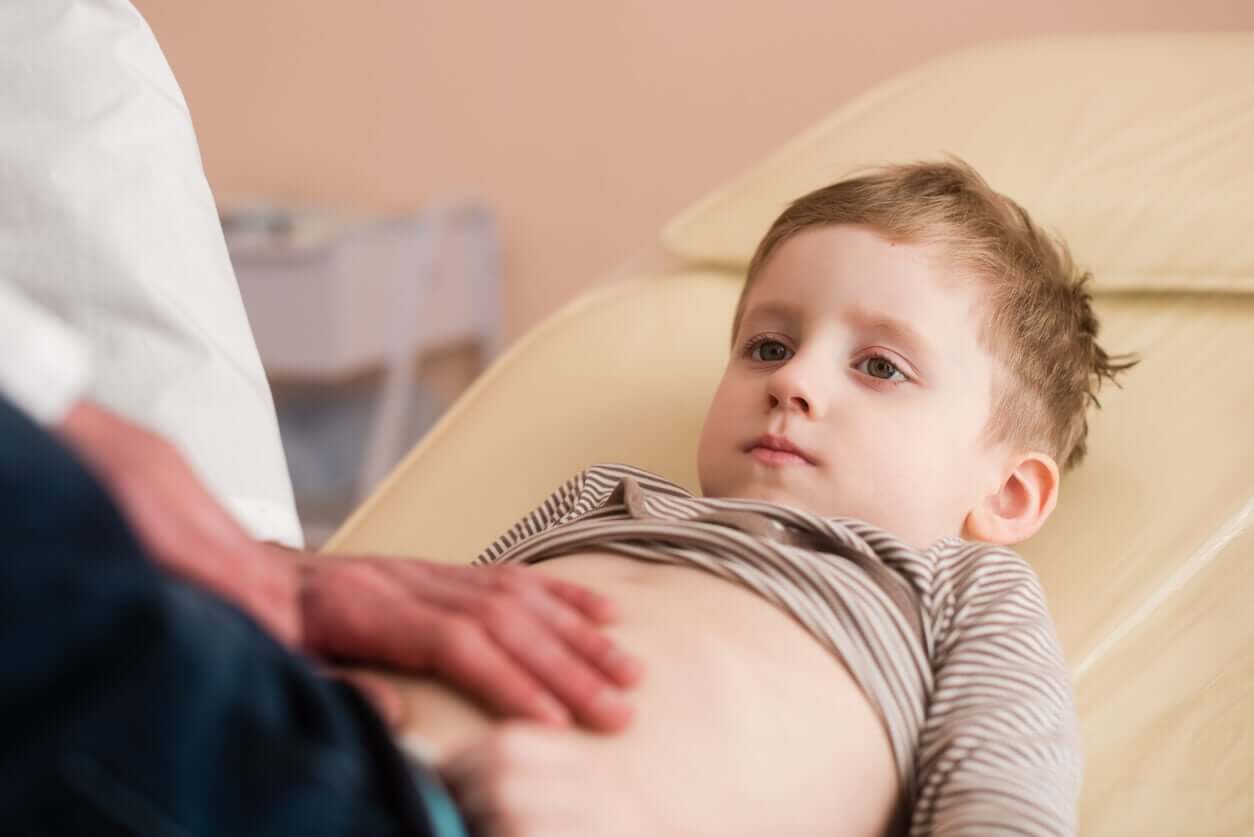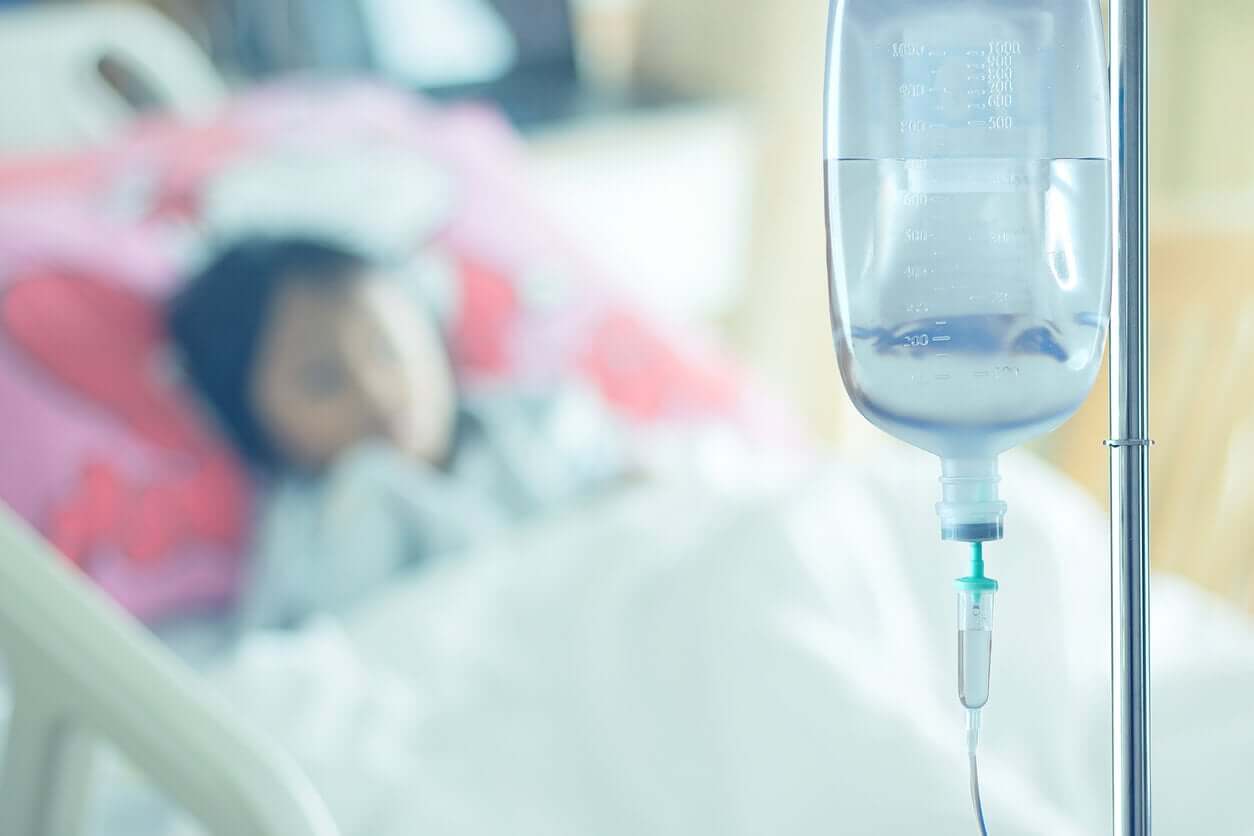Infant Neuroblastoma: Symptoms, Causes and Treatment

Infant neuroblastoma is a type of cancer that occurs most often in early childhood. Although it’s not one of the most frequent diseases in pediatrics, its diagnosis causes great anguish and concern for parents.
Despite how much this disease has been studied, there are still many questions to be answered. Unfortunately, one of its main characteristics is the variability in its forms of presentation, as well as in the survival prognosis.
In the following article, we’ll tell you everything you need to know about this pathology.
What is infant neuroblastoma?
Neuroblastoma is a solid-type malignant tumor that occurs in cells of the peripheral nervous system (PNS). This system consists of nerves and other structures that link the brain and spinal cord to the rest of the organs.
Currently, it accounts for 7% of all pediatric cancers and is the second most common solid tumor after central nervous system (CNS) tumors. For this reason, experts say it’s the most common extracranial tumor in childhood.
Why does infant neuroblastoma happen?
When alterations or mutations occur in the genetic information of a type of immature cells of the PNS (neuroblasts), they begin to multiply uncontrollably. As a result, solid masses form in different parts of the body, causing a huge variety of symptoms.
In general, these types of mutations are usually de novo, that is, children haven’t inherited them from their parents. Only 1% to 2% of neuroblastomas are inherited, while most cases are the result of defects in different genes, for unclear reasons.
Currently, experts haven’t identified any direct associations between any environmental, chemical, or biological factors and the risk of suffering from this disease.
How does neuroblastoma appear?
As we mentioned earlier, one of the main characteristics of neuroblastoma is its variability or heterogeneity. This means that the diagnosis, in general, takes place late.
This tumor can form anywhere along the parasympathetic nerve chain that makes up the PNS. The most frequent site of appearance is at the level of the adrenal glands (40% of cases), the neck and thorax (20%), or the pelvis (5-15%). (Maris J, 2007)
The symptoms are mainly the result of compression or invasion of certain organs, as when the manifestations appear the tumor has acquired a considerable size. Likewise, at the time of diagnosis, in general, tumor cells have already spread throughout the child’s body.

Common symptoms of neuroblastoma in children
As we’ve noted, the manifestations are highly variable, depending on the site where the tumor is present. Among the most frequent symptoms are the following:
- Fatigue, decay, and loss of appetite
- Weightloss
- Palpable and hard masses at the level of the abdomen or neck
- Paleness, dark circles, or bruises in different locations
- Pain in the bones or limbs
- Ocular involvement, characterized by drooping of the eyelids and dry eye (Horner’s Syndrome)
- Palpitations, flushing in the face, and increased blood pressure
- Diarrhea, constipation, or abdominal pain
It’s important to note that none of these symptoms are specific to this condition, which makes early diagnosis in children very difficult.
What tests do doctors perform to confirm the diagnosis of infant neuroblastoma?
When there’s suspicion of infant neuroblastoma, consultation with a Pediatric Oncology specialist is essential, both for conducting studies and establishing the treatment plan.
First, the doctor will necessary to carry out an interview with the family to know the personal and family history of the child. Also, they’ll gather details on the evolution of the current picture.
Depending on the patient, the doctor will determine the type of studies to carry out. In general, the tests that are necessary in order to corroborate the diagnosis are the following:
- Blood test
- Urine analysis
- Computed tomography (chest, abdomen, and pelvis)
- Brain nuclear magnetic resonance
- Scintigraphy or MIBG scintigraphy
- Bone marrow biopsy puncture
- Tumor biopsy
Neuroblastoma staging
Tumor stratification establishes both the risk of mortality and the choice of treatment.
This is determined according to the clinical characteristics of the disease (symptoms, tumor extension, age of appearance) and biological characteristics (the results of some complementary tests).
Since 2008, experts have used the International Neuroblastoma Risk Group Staging System, which defines 4 types of neuroblastoma:
- Regional tumors: L1 or L2, according to the presence or absence of risk factors according to images (Image-defined risk factors or IDRFs).
- Metastatic tumors: They’re identified by the letter M. Among them, MS is one that occurs in children under 18 months, with metastases in the skin, liver, or bone marrow.
The treatment of infant neuroblastoma
The treatment of neuroblastoma is a huge challenge for professionals and requires the joint work of different specialists.
First of all, it’s important to know the particular situation of each child, as well as the type of neuroblastoma that they have. This helps to define the objectives and to agree on the strategies with the family, according to the survival prognosis of each infant.
In general, treatments for neuroblastoma include the following alternatives:
- Monitoring and observation
- Surgery
- Chemotherapy
- Radiotherapy
- Radioactive iodine therapy
- Immunotherapy (or targeted therapy with special antibodies)

Is it possible to cure infant neuroblastoma?
In some cases, a cure is possible. But this will depend on many factors. For example, the age of the child at the time of diagnosis, the extension of the primary tumor, the presence of certain mutations in specific genes, among others.
In most cases, when the diagnosis of neuroblastomas takes place before 18 months of age, the prognosis is better than those with a later diagnosis. This has to do, mainly, with the type of mutation they present.
Similarly, in the case of more aggressive tumors, treatment can greatly limit the disease and even cure the child. However, the risk that the tumor will reappear may be unlikely or very likely, depending on the case.
About infant neuroblastoma
Neuroblastoma isn’t one of the most common childhood diseases, but it’s one of the main pediatric tumors and the first in frequency in infants.
In general, the diagnosis takes place in advanced stages, when the symptoms show that the tumor has expanded considerably. Therefore, it’s essential that parents carry out all health checks with the pediatrician in order to anticipate as much as possible.
Infant neuroblastoma is a type of cancer that occurs most often in early childhood. Although it’s not one of the most frequent diseases in pediatrics, its diagnosis causes great anguish and concern for parents.
Despite how much this disease has been studied, there are still many questions to be answered. Unfortunately, one of its main characteristics is the variability in its forms of presentation, as well as in the survival prognosis.
In the following article, we’ll tell you everything you need to know about this pathology.
What is infant neuroblastoma?
Neuroblastoma is a solid-type malignant tumor that occurs in cells of the peripheral nervous system (PNS). This system consists of nerves and other structures that link the brain and spinal cord to the rest of the organs.
Currently, it accounts for 7% of all pediatric cancers and is the second most common solid tumor after central nervous system (CNS) tumors. For this reason, experts say it’s the most common extracranial tumor in childhood.
Why does infant neuroblastoma happen?
When alterations or mutations occur in the genetic information of a type of immature cells of the PNS (neuroblasts), they begin to multiply uncontrollably. As a result, solid masses form in different parts of the body, causing a huge variety of symptoms.
In general, these types of mutations are usually de novo, that is, children haven’t inherited them from their parents. Only 1% to 2% of neuroblastomas are inherited, while most cases are the result of defects in different genes, for unclear reasons.
Currently, experts haven’t identified any direct associations between any environmental, chemical, or biological factors and the risk of suffering from this disease.
How does neuroblastoma appear?
As we mentioned earlier, one of the main characteristics of neuroblastoma is its variability or heterogeneity. This means that the diagnosis, in general, takes place late.
This tumor can form anywhere along the parasympathetic nerve chain that makes up the PNS. The most frequent site of appearance is at the level of the adrenal glands (40% of cases), the neck and thorax (20%), or the pelvis (5-15%). (Maris J, 2007)
The symptoms are mainly the result of compression or invasion of certain organs, as when the manifestations appear the tumor has acquired a considerable size. Likewise, at the time of diagnosis, in general, tumor cells have already spread throughout the child’s body.

Common symptoms of neuroblastoma in children
As we’ve noted, the manifestations are highly variable, depending on the site where the tumor is present. Among the most frequent symptoms are the following:
- Fatigue, decay, and loss of appetite
- Weightloss
- Palpable and hard masses at the level of the abdomen or neck
- Paleness, dark circles, or bruises in different locations
- Pain in the bones or limbs
- Ocular involvement, characterized by drooping of the eyelids and dry eye (Horner’s Syndrome)
- Palpitations, flushing in the face, and increased blood pressure
- Diarrhea, constipation, or abdominal pain
It’s important to note that none of these symptoms are specific to this condition, which makes early diagnosis in children very difficult.
What tests do doctors perform to confirm the diagnosis of infant neuroblastoma?
When there’s suspicion of infant neuroblastoma, consultation with a Pediatric Oncology specialist is essential, both for conducting studies and establishing the treatment plan.
First, the doctor will necessary to carry out an interview with the family to know the personal and family history of the child. Also, they’ll gather details on the evolution of the current picture.
Depending on the patient, the doctor will determine the type of studies to carry out. In general, the tests that are necessary in order to corroborate the diagnosis are the following:
- Blood test
- Urine analysis
- Computed tomography (chest, abdomen, and pelvis)
- Brain nuclear magnetic resonance
- Scintigraphy or MIBG scintigraphy
- Bone marrow biopsy puncture
- Tumor biopsy
Neuroblastoma staging
Tumor stratification establishes both the risk of mortality and the choice of treatment.
This is determined according to the clinical characteristics of the disease (symptoms, tumor extension, age of appearance) and biological characteristics (the results of some complementary tests).
Since 2008, experts have used the International Neuroblastoma Risk Group Staging System, which defines 4 types of neuroblastoma:
- Regional tumors: L1 or L2, according to the presence or absence of risk factors according to images (Image-defined risk factors or IDRFs).
- Metastatic tumors: They’re identified by the letter M. Among them, MS is one that occurs in children under 18 months, with metastases in the skin, liver, or bone marrow.
The treatment of infant neuroblastoma
The treatment of neuroblastoma is a huge challenge for professionals and requires the joint work of different specialists.
First of all, it’s important to know the particular situation of each child, as well as the type of neuroblastoma that they have. This helps to define the objectives and to agree on the strategies with the family, according to the survival prognosis of each infant.
In general, treatments for neuroblastoma include the following alternatives:
- Monitoring and observation
- Surgery
- Chemotherapy
- Radiotherapy
- Radioactive iodine therapy
- Immunotherapy (or targeted therapy with special antibodies)

Is it possible to cure infant neuroblastoma?
In some cases, a cure is possible. But this will depend on many factors. For example, the age of the child at the time of diagnosis, the extension of the primary tumor, the presence of certain mutations in specific genes, among others.
In most cases, when the diagnosis of neuroblastomas takes place before 18 months of age, the prognosis is better than those with a later diagnosis. This has to do, mainly, with the type of mutation they present.
Similarly, in the case of more aggressive tumors, treatment can greatly limit the disease and even cure the child. However, the risk that the tumor will reappear may be unlikely or very likely, depending on the case.
About infant neuroblastoma
Neuroblastoma isn’t one of the most common childhood diseases, but it’s one of the main pediatric tumors and the first in frequency in infants.
In general, the diagnosis takes place in advanced stages, when the symptoms show that the tumor has expanded considerably. Therefore, it’s essential that parents carry out all health checks with the pediatrician in order to anticipate as much as possible.
All cited sources were thoroughly reviewed by our team to ensure their quality, reliability, currency, and validity. The bibliography of this article was considered reliable and of academic or scientific accuracy.
- Maris J. M., Hogarty M. D., Bagatell R., Cohn S. L. Neuroblastoma. Lancet. 2007;369(9579):2106–2120. doi: 10.1016/S0140-6736(07)60983-0. Disponible en: https://www.thelancet.com/journals/lancet/article/PIIS0140-6736(07)60983-0/fulltext
-
Balaguer J, Castel V. Neuroblastoma. An Pediatr Contin. 2008;6(5)276-83. Disponible en: https://www.elsevier.es/es-revista-anales-pediatria-continuada-51-articulo-neuroblastoma-S1696281808748807
- Tomolonis J, Agarwal S, Shohet J. Neuroblastoma pathogenesis: deregulation of embryonic neural crest development. Cell Tissue Res. Author manuscript; available in PMC 2018 May 1. Disponible en: https://www.ncbi.nlm.nih.gov/pmc/articles/PMC5918240/
- Morosini Fabiana, Castiglioni Mariela, Pagés Carolina, Simón Elizabeth, Zuccolo Silvana, Silveira Anaulina et al . Neuroblastoma en niños menores de 18 meses: Experiencia de 10 años en Centro Hematooncológico Pediátrico del Centro Hospitalario Pereira Rossell. Arch. Pediatr. Urug. [Internet]. 2013 [citado 2021 Sep 06] ; 84( 2 ): 84-90. Disponible en: http://www.scielo.edu.uy/scielo.php?script=sci_arttext&pid=S1688-12492013000200002&lng=es.
- Instituto Nacional del Cáncer. Tratamiento del neuroblastoma – Versión para pacientes. National Institute of Health (USA) website. [Internet] Disponible en: https://www.cancer.gov/espanol/tipos/neuroblastoma/paciente/tratamiento-neuroblastoma-pdq#
- Kholodenko I, Kalinovsky D, Kholodenko R, et al. Neuroblastoma Origin and Therapeutic Targets for Immunotherapy. J Immunol Res. 2018; 2018: 7394268. Disponible en: https://www.ncbi.nlm.nih.gov/pmc/articles/PMC6079467/#idm139651834577008title
This text is provided for informational purposes only and does not replace consultation with a professional. If in doubt, consult your specialist.








